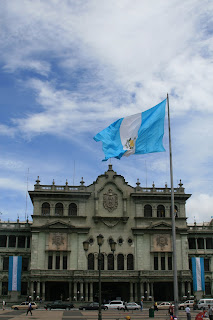 In Pride and Pain - a Guatemalan Journey
In Pride and Pain - a Guatemalan JourneyVictor is an auto mechanic. Sitting in the shade of Guatemala City's Parque Central, he talks politely about elections and evangelism. His vote in the Sept. 9 first round presidential elections was a fatalistic one. At the mention of Otto Perez Molina and Alvaro Colom, he upturns his palm and scrunches his face in indifference.
Neither candidate gives him much hope. For that, Victor points to the sky, to the perennial incumbent.
"Jesus Cristo," he says, "is all that really matters."
Behind him a massive blue and white Guatemalan flag cracks in the wind in front of the Palacio Nacional. The Parque Central is decorated for independence day on Sept. 15. But when the happy music of the marimba fades and the flag flutter and fanfare die away, Guatemala's history still echoes for those who listen.
Not 30 meters from the flag in Parque Central stand the pillars surrounding the Cathedral, on which are written the names of the 200,000 people who were killed or disappeared in Guatemala's 36-year civil war. The names etched in the stones remain a painful stain on the country's nationalism. It's a stain that lingers. Eleven years after the 1996 peace accords ended the civil war, the perpetrators of the massacres of the indigenous Mayan remain at large. One of the worst, Efrain Rios Montt, just won a seat in Guatemala's Congress, and hopes this will ensure him immunity from prosecution for another four years.
The two main contenders, Otto Perez Molina and Alvaro Colom, campaigned on slogans of security and hope, respectively. Molina promised to rule Guatemala with a 'mano dura,' a strong fist, to crack down on a crime rate that is one of the worst in the Americas. In 2006, Guatemala's murder rate was 110 per 100,000, over twice that of Colombia's. But as an ex-general in the army, Molina also generates frightening memories of the army's role in the civil war massacres.
 Colom is accused of being backed by narco-traffickers. About 75 percent of the cocaine that ends up in the U.S. passes through Guatemala.
Colom is accused of being backed by narco-traffickers. About 75 percent of the cocaine that ends up in the U.S. passes through Guatemala.And both candidates can attribute their success to backing from Guatemala's wealthy, powerful industry-owning families.
The only Mayan candidate in the running, the Nobel-peace-prize-winning Rigoberta Menchu, lacked the resources to splash her party's name along the roadsides like the other parties. She also lacked the money to buy villagers machetes and promise them bridges and other projects in exchange for votes. In this fiscal democracy, the promised bridges are seldom built, but a new machete is nice, and the villagers have scant hopes for change anyway.
The runoff elections between Molina and Colom are scheduled for Nov. 4. But as both candidates tour the country and paint billboards the orange and green of their parties, few in Guatemala are holding their breath.
'We are made from corn'
Leaving Guatemala City in any direction, the countryside is a patchwork of agriculture draped across the lumpy mountains. Coffee, beans and corn are major crops in this fertile, volcanic soil. Guatemala is the primary exporter of coffee for Starbucks. The Mayans say they were made from corn. They eat it in tortillas, tamales, and straight off the cobb, and drink it liquified in a variety of hot drinks called atol.
 In March, 2005, the Guatemalan government ostensibly opened the country's markets to trade with the U.S. by ratifying the Central American Free Trade Agreement. But two years on, CAFTA has only benefited the rich plantation owners, like the vast banana fincas of Dole and Del Monte.
In March, 2005, the Guatemalan government ostensibly opened the country's markets to trade with the U.S. by ratifying the Central American Free Trade Agreement. But two years on, CAFTA has only benefited the rich plantation owners, like the vast banana fincas of Dole and Del Monte.Moreover, in a country that founded its civilization on corn and pulls two harvests a year from stalks that grow to 15 feet, Guatemala ironically imports the crop from the U.S. The American government subsidizes corn so heavily that when it hits the market, the value of Guatemala's corn drops to almost nothing. As a result, villages cannot compete in the free markets of the globalized economy, and instead languish in poverty.
But not everyone stays. Some choose to risk the dangers and pay the $2-3,000 to pay for a coyote to bring them into the U.S. If they make it across the desert, they send back money to their families, constituting a major part of the national economy. In 2005, these remittances amounted to $3 billion, 10 percent of the country's GDP.
Travel through Guatemala as a gringo and issues of immigration are always close at hand. One street food vendor in Guatemala City half-jokingly asked if I had a sister he could marry so he could get a green card.
Another young boy, the conductor of a small bus weaving through the central Guatemalan hills, talked to me as he hung on at the doorway. He was 15, perhaps, in boots, jeans, tucked tee-shirt and a Levis cap. Shouting our destination out the door, at various passerby, he was still learning about the reflexes of the world. He turned to look at me in earnest.
"Can I come back with you, to the States?" he asked. "I can work for you for three years, I'm a hard worker, and fast."
